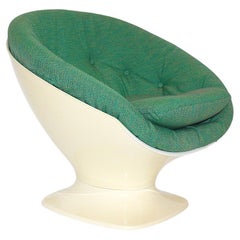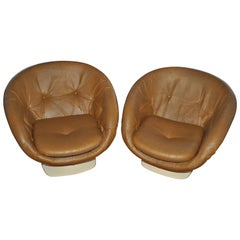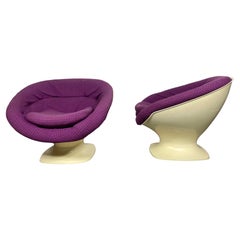Rafael Raffel Chair
Vintage 1970s French Space Age Club Chairs
Fabric, Plastic
Recent Sales
Vintage 1960s French Mid-Century Modern Armchairs
Faux Leather, Fiberglass
Vintage 1970s Space Age Lounge Chairs
Fabric, Plastic
Mid-20th Century French Mid-Century Modern Club Chairs
Lucite
Mid-20th Century French Mid-Century Modern Club Chairs
Lucite
Raphael Raffel for sale on 1stDibs
Best known in the world of design as simply Raphaël, Raphaël Raffel was one of the most influential French mid-century modern designers and decorators. His style inspirations ranged from 18th-century Parisian design to 1960s American and Italian Space Age chic.
Born in 1912 in Paris, Raffel studied design at the École des Beaux-Arts. In 1934, he began an interior decorating business, counting legendary French-American dancer Josephine Baker among his first clients.
During the 1930s and throughout the 1940s, Raffel was regarded as one of France’s illustrious “ensembliers-décorateurs,” designers who not only created furniture but focused on every element of interior space, from wall decorations to lighting.
By the 1950s, Raffel’s decorating and design talents had gained the attention of the French public service. Several commissions were awarded to Raffel to decorate embassies, university residences, post offices, the National Assembly and the ground floor and a wing of the Hôtel de Ville de Paris. Additionally, in 1952, Raffel worked with French designer, sculptor and architect André Arbus to decorate a section of the luxury ocean liner Bretagne. That same year, Raffel’s work was shown with designs by French ceramist Georges Jouve at the Salon des Arts Ménagers. In 1958, Raffel exhibited at the Brussels World’s Fair.
During the 1960s and 1970s, Raffel was inspired by the era’s popular Space Age style, evident in his plush, croissant-shaped sofas and pod-shaped lounge chairs, club chairs and armchairs, which he designed for furniture makers such as Maison Honoré and Herman Miller. Raffel also combined lacquer, glasswork, distinct colors and gilt bronze in his elegant, French neoclassical coffee and cocktail tables, side tables and desks.
Towards the end of the 1970s, Raffel’s business began to wane, finally closing in 1983. Raffel continued to work on design and decorating commissions until he died in 2000.
On 1stDibs, find a range of vintage Raphaël Raffel seating and tables.
Materials: Plastic Furniture
Arguably the world’s most ubiquitous man-made material, plastic has impacted nearly every industry. In contemporary spaces, new and vintage plastic furniture is quite popular and its use pairs well with a range of design styles.
From the Italian lighting artisans at Fontana Arte to venturesome Scandinavian modernists such as Verner Panton, who created groundbreaking interiors as much as he did seating — see his revolutionary Panton chair — to contemporary multidisciplinary artists like Faye Toogood, furniture designers have been pushing the boundaries of plastic forever.
When The Graduate's Mr. McGuire proclaimed, “There’s a great future in plastics,” it was more than a laugh line. The iconic quote is an allusion both to society’s reliance on and its love affair with plastic. Before the material became an integral part of our lives — used in everything from clothing to storage to beauty and beyond — people relied on earthly elements for manufacturing, a process as time-consuming as it was costly.
Soon after American inventor John Wesley Hyatt created celluloid, which could mimic luxury products like tortoiseshell and ivory, production hit fever pitch, and the floodgates opened for others to explore plastic’s full potential. The material altered the history of design — mid-century modern legends Charles and Ray Eames, Joe Colombo and Eero Saarinen regularly experimented with plastics in the development of tables and chairs, and today plastic furnishings and decorative objects are seen as often indoors as they are outside.
Find vintage plastic lounge chairs, outdoor furniture, lighting and more on 1stDibs.
Finding the Right club-chairs for You
Traditionally covered in leather and abundantly luxurious, antique and vintage club chairs are among the most comfortable pieces of furniture that you could ever bring into your living room. The classic club chair is one of the 52 types of chairs to know when decorating your home.
While the club chair was especially popular in France during the 1920s — known there as fauteuil confortable (or “comfortable armchair”) — modern versions are derived from those used in 19th-century English gentlemen’s clubs, which is believed to be the origin of their name. A riff on the traditional armchair, these seats typically have low backs, extra-wide armrests and more than sufficient padding to support extended lounging.
Well-known modern interpretations of the club chair can be found in Marcel Breuer’s pared-down Wassily lounge chair and in the cube-like seats of the LC collection, designed by Charles-Édouard “Le Corbusier” Jeanneret, Pierre Jeanneret and Charlotte Perriand. Debuting in 1956, the celebrated Eames lounge chair was a fresh, subversive new take on the classic English club chair and a culmination of experimentation by Charles and Ray Eames, its inventive creators.
When shopping for any style of club chair, be it a mid-century modern club chair, an Art Deco club chair or another type, you’ll want to think about the room you have in mind for this distinct seating. Club chairs occupy a lot of real estate, as they’re usually larger than standard chairs. (You’ll want to make certain that there is at least one foot of space around the chair, for example, to ensure the sitter doesn’t feel cramped and that there is room to move freely around the furnishing.) And although they were originally upholstered in leather, contemporary iterations of the club chair can be found in fabric and plastic.
Introduce a decadent atmosphere and a whole lot of comfort in your living room or reading nook. Explore a collection of antique, new and vintage club chairs on 1stDibs.


